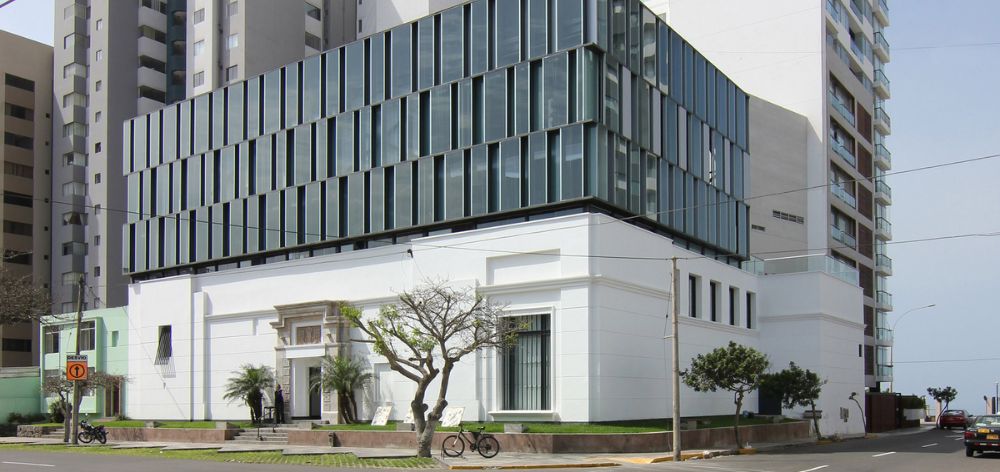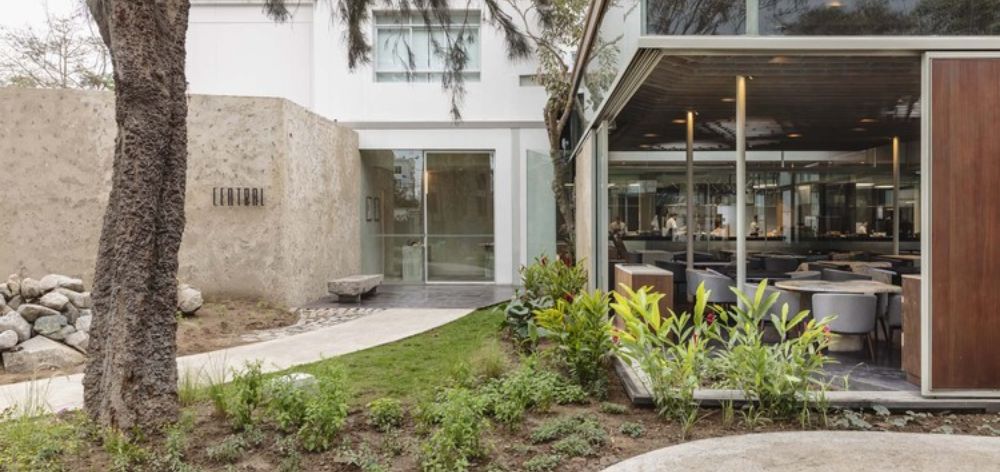A few days ago, I turned to the NYTimes to find a beautifully written piece by Michael Snyder on the prismatic, concrete-shrouded home of celebrated Peruvian artist Miguel Andrade in Lima. This came as a reminder of the growing architectural scene streaming out of the coastal metropolis, which as of today, nurtures and takes from the eclectic, motley history of the city as well as the currently favored isms around the globe.
Here at Terra Explorer, we’ll shortly dive into 5 contemporary buildings in Peru that inspire architects, designers, and artists alike. Make sure to add them to your architectural tour when talking to your bespoke travel advisor. Full disclosure: Much has been written about the UTEC Campus, so just for once will skip that one.
This is part two, so make sure to glance through our Historical Architectural Tour Of Peru.
Initially commissioned to be the headquarters of the Fishing Ministry, this is the prime iteration of brutalist architecture in Peru. Today, it houses the Ministry of Culture as well as a convention center. The enormous concrete edifice is not only imposing on the outside but on the inside. The entrance hall seizes on the full height of the building, and skylights illuminate the interiors. In fact, natural light steals the show as it even radiates from behind a golden Inca sun encrusted high up the grayish walls.
This is a masterful stroke by Peruvian architects, all reared at faculties in Lima. Find it sitting along the bustling Javier Prado Avenue in San Borja.

Sandra Barclay and Jean Pierre Crousse are probably Peru’s most laureled and well-known architects. Their oeuvre has earned them a constellation of international awards. And Corriente Alterna is a detour from their Neo-brutalist approach to construction —one that usually transubstantiates pre-Columbian architectural minimalism into contemporary functions and forms.
This work, in particular, consists of a glass blanketed addition “floating” over a historic building by Emilio Harth Terré. The original edifice, baptized by some as Neo-Inca because of its Inca Inspired ornamentation—designed under a post-Beaux-Arts lens— was formerly the residence of the architect. Today, it is home to an Art and Design school. Barclay and Crousse opted for a tripartition of the two-story attachment in hopes of not overtaking Harth’s creation. Strings of frosted and transparent glass sheets jut irregularly along the three files to an astonishingly modern yet ethereal effect.
This is more in line with Sandra’s and Jean Pierre’s preferred aesthetic of monumental stark concrete. The building —a museum dedicated to the long-gone times of terrorism in Peru— seizes on an impossible landscape: the cliffs along Lima’s coasts. In a way, the edifice angularly continues the geological forms, as it is almost encrusted within the escarpment. And so, the unobstructed views of the Pacific are one of the highlights.
The severe concrete merges harmonically with the arid precipices and the native autumnal vegetation. The entrance, a prolonged walkway from the bustling city streets, invites the visitor into a more secluded yet grand place. A system of stairs and terraces —an echo of pre-Columbian architecture—leads to a handful of spaces that can be used independently for other purposes besides its archivist end, as it becomes a new public space for culture and leisure.

Although visually undisclosed, this is a study on materials and construction techniques whose provenance speaks of the multiplicity of terrains and traditions in Peru —and how geography and biodiversity have delimited architecture’s materialization for millennia. Thus, the restaurant is, perhaps inconspicuously, filled with materials (masonry, columns, tables, and so on) from the myriad of Peruvian biospheres, all forged and worked by local artisans —they are central to Rafael’s team—to appear rather raw. Amazonian wood, earthen plaster from Lima, and stone countertops from the Andes are just a few of the more “feral” mediums, all coexisting along much modern, polished forms —those part of our universal design language.
To indeed appreciate the building, I recommend you stop by Rafael Freyre’s website to read the whole story. Oh, and by the way, as of 2022, Central by chefs Virgilio Martinez and Pía León is the second best restaurant in the world according to the closely watched list The 50 Best. Find it in Barranco.
Related: 5 must go restaurants in Peru.
Yes, this is a residential building, so you won’t be able to simply walk in. Still, that doesn’t restrain architectural aficionados like us from admiring the splendorous facade, which takes notes from the 20th-century aesthetics of Barranco —when it was a summer retreat town for the elites. French wood-framed windows occupy the tripartite structure, and an ivory cornice protrudes over the gray walls. Thus, making this edifice an austere, astonishing reinterpretation of the history of the place.
And there you have it, 5 contemporary buildings every architecture aficionado must visit in Peru. And if you’re looking for private art tours or cultural outings in this southern nation, contact our team of experts for a tailor-made trip to Peru.
To ensure the well-being and safety of our travelers and staff throughout our operational chain, Terra Explorer will comply with the health and safety measures and protocols established by the Peruvian Association of Adventure Tourism and Ecotourism (APTAE), and implement the Covid-19 health and safety guidelines for adventure tourism developed by the Adventure Travel Trade Association (ATTA).
Our experiences are designed considering the least possible exposure, where the final destinations are usually remote places. By their very nature, our adventure activities are considered to be low risk, mainly because they are performed outdoors where ventilation is constant and making it easy to achieve social distancing.
During these times we are working together with a small staff of honorable people who have been part of the Terra Explorer family for many years. They and their families are aligned with the established health and safety measures. Employing these staff members also seeks to reactivate the local economy.
We guarantee a safe, soul-fulfilling trip to all our travelers for whom we make these adventures possible.
Terra Explorer will strictly comply with the safety, cleaning, and hygiene protocols during our internal processes, third parties, and throughout your trip. This involves:
Follow the instructions related to health and safety given by the Terra Explorer team and your guide, before and during your trip.
Stay home if:
With the intention of delivering the most flexibility at the time of confirming your trip, we will determine the amount of the initial deposit individually and according to your itinerary characteristics.
Secure your trip with a deposit and pay the rest in one or more payments, at a time that suits you best. Please make sure you adhere to our policy and pay in full at least 31 days prior to your trip date.
If you need to cancel your trip, we will apply the following flexible policies.
For more detailed information on our terms and conditions and Covid-19 policies, please contact us at [email protected]